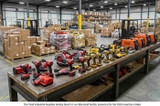Maximizing Workshop Efficiency with Air Tools: A Detailed Look at PSI Requirements and Air Consumption
Maximizing Workshop Efficiency with Air Tools: A Detailed Look at PSI Requirements and Air Consumption
Key takeaways of this article
- Understanding Air Tools: Air tools, powered by compressed air, are essential in many workshops. They come in various types, each designed for specific tasks.
- PSI Requirements: PSI (Pounds per Square Inch) is a critical factor in the operation of air tools. Different tools have different PSI requirements, and understanding these is crucial for their optimal performance.
- Air Consumption: The amount of air a tool consumes during operation can impact both its performance and the load on the air compressor. It's important to understand and manage air consumption effectively.
- Maximizing Efficiency: Proper management of PSI settings and air consumption can significantly improve the efficiency of a workshop. This involves optimizing PSI settings for different tools and managing air consumption to prevent compressor overload.
- Real-World Application: The article provides real-world examples of how proper PSI and air consumption management can lead to noticeable improvements in workshop efficiency.
- Tend Industrial Supplies LLC: Encouraging readers to explore the range of air tools available at Tend Industrial Supplies LLC to enhance their workshop's performance.
Introduction
In the bustling environment of a workshop, efficiency, and precision are paramount. One of the key contributors to these aspects is air tools, also known as pneumatic tools. Powered by compressed air, these tools have become a staple in many workshops due to their reliability, power, and versatility. This article aims to delve into the intricacies of air tools, focusing on their PSI requirements and air consumption - two critical factors that can significantly impact their performance and your workshop's overall productivity. Air tools are an easy way to get the right power to tools on site. An important factor in choosing a suitable air compressor for your workshop is the PSI requirements of the tools. It would help if you also considered the different aspects of air consumption to help you select an air compressor that will be right for your workshop.
Using the right tools can help you get the job done safely and quickly. This holds true for equipment when working in an industrial environment or even at a construction site. But what about when you are working on a project that requires expertise and craftsmanship? These tools can help maximize workshop efficiency, so you need air tools. We also have a blog on maximizing your air tool efficiency here.
Understanding Air Tools
Air tools operate on a simple yet effective principle. They use the force of compressed air to generate power, eliminating the need for electricity or batteries. This compressed air is typically supplied by an air compressor, which sends the air through a hose to the tool. The result is a tool that is powerful, lightweight, and easy to handle, making it ideal for various tasks in a workshop setting.
A wide array of air tools are available, each designed for specific applications. Some of the most commonly used in workshops include air drills for making holes, air impact wrenches for loosening and tightening nuts and bolts, air ratchets for mechanical work, air sanders for smoothing surfaces, and air spray guns for painting. Each of these tools brings unique benefits and can significantly enhance the efficiency and capabilities of a workshop when used correctly.
Understanding how air tools work and the different types available is the first step toward maximizing their potential. However, to truly harness their power, one must also understand PSI requirements and air consumption concepts, which we will explore in the following sections.
The Importance of PSI in Air Tools
PSI, or Pounds per Square Inch, is a unit of pressure used in various fields, including the operation of air tools. It refers to the amount of compressed air pressure generated by the air compressor and delivered to the air tool. The PSI level is crucial as it directly influences the power and efficiency of the tool.
Different air tools typically have different PSI requirements, always specified by the manufacturer. For instance, an air impact wrench may require a higher PSI than an air spray gun due to the nature of its work. It's essential to adhere to these requirements to ensure optimal tool performance and prevent any potential damage.
The PSI level can significantly impact an air tool's performance. A tool operated at a lower PSI than required may not function effectively, leading to subpar results and longer project times. Conversely, using a tool at a higher PSI than recommended can cause excessive wear and tear, shortening the tool's lifespan. Therefore, understanding and correctly managing PSI is critical to maintaining the efficiency and longevity of your air tools.
Air Consumption of Pneumatic Tools
Air consumption, often measured in Cubic Feet per Minute (CFM), refers to the air an air tool uses during operation. It's another crucial factor to consider when working with air tools, as it directly impacts the tool's performance and the air compressor's capacity.
Several factors can affect the air consumption of air tools. These include the size and type of the tool, the PSI level, and the duration of use. For example, larger tools or those used at higher PSI levels will generally consume more air.
Calculating and managing air consumption is essential to ensure your air compressor can adequately supply your tools. To calculate, you can find the CFM requirement of each tool in the user manual or on the manufacturer's website. Add up the CFM requirements of all the tools that might be used simultaneously to determine the total air consumption.
Your air compressor should be able to deliver at least that amount, plus an additional 30% to account for any inefficiencies or leaks in the system. By understanding and managing air consumption, you can ensure a smooth and efficient operation in your workshop, preventing any downtime due to an overworked air compressor.
Maximizing Workshop Efficiency with Proper PSI and Air Consumption Management
Managing PSI and air consumption is always key to maximizing the efficiency of your workshop. Here are some strategies and tips to help you achieve this:
Optimizing PSI Settings:
- Always refer to the manufacturer's guidelines for the recommended PSI settings for each tool.
- Use a quality air pressure regulator to set and maintain the correct PSI accurately.
- Remember, using the proper PSI ensures optimal tool performance and extends the tool's lifespan.
Managing Air Consumption: Regularly monitor the air consumption of your tools and the capacity of your air compressor. If you notice that your compressor needs help or needs help to keep up, consider upgrading to a higher capacity model or staggering the use of your tools to avoid overloading the compressor. Regular air tools and compressor maintenance can also help reduce air consumption by ensuring everything is working efficiently.
Let's consider a real-world example. A car repair workshop struggled with slow work processes because their air tools needed to operate at full capacity. After reviewing their PSI settings and air consumption, they realized their air compressor was not powerful enough to meet the demands of their tools. They invested in a larger capacity compressor and properly adjusted their PSI settings. As a result, they saw a significant improvement in tool performance and workshop efficiency.
Conclusion
Understanding and managing PSI requirements and air consumption are crucial to working with air tools. They directly impact your tools' performance and your workshop's overall efficiency. By optimizing PSI settings and effectively managing air consumption, you can ensure your tools operate at their best, leading to improved results and productivity.
At Tend Industrial Supplies LLC, we understand the importance of these factors and offer a wide range of high-quality air tools and compressors to meet your needs. We're here to help you maximize workshop efficiency with the right tools and advice. For more information, visit our website at tendsupplies.com or sales@tendsupplies.com. Let us help you make the most of your workshop with the best tools in the industry.








